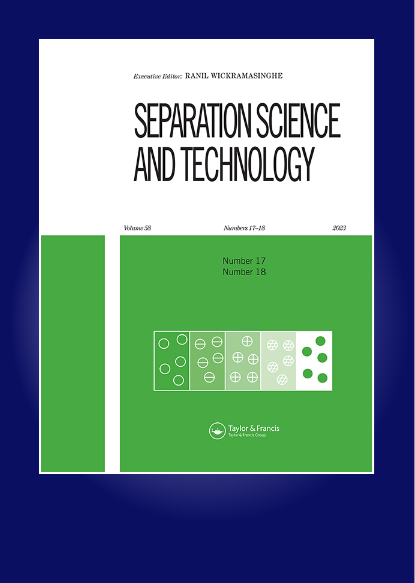热集成连续三柱萃取精馏分离二二元共沸乙腈-环己烷-甲苯三元混合物:设计、模拟和多目标遗传算法优化
IF 2.3
4区 工程技术
Q3 CHEMISTRY, MULTIDISCIPLINARY
引用次数: 0
摘要
摘要采用可持续的方法分离共沸混合物,如萃取精馏,对环境和资源的可持续性至关重要。环己烷、乙腈和甲苯是不同化学过程中必不可少的溶剂。这种三元混合物在常压下具有环己烷-乙腈和乙腈-甲苯两种二元共沸物。利用残留曲线图和单挥发性曲线,选择正丁基苯作为萃取精馏的可行夹带剂。与传统的设计不同,在这个模拟中,回收的夹带器只被送到第一柱。回收的夹带器所产生的废能,通过一体化的方式为再沸器供能。为了更好地理解分离过程,进行了三维物料衡算。高纯度的乙腈、环己烷和甲苯也将从第一、第二和第三色谱柱得到。最后,利用包含14个关键决策变量的多目标遗传算法,从经济、环境和能源效率的角度出发,以降低年总成本(TAC)和二氧化碳排放、提高热力效率为目标函数。优化结果表明,与传统的萃取精馏相比,热集成设计减少了近25%的TAC和46%的二氧化碳排放,并且对热力学效率没有显著影响。本研究对从其它三元混合物中分离共沸体系具有一定的参考价值。关键词:共沸分离三元体系萃取蒸馏模拟多目标遗传优化公开声明作者未报告潜在利益冲突。补充材料本文的补充数据可以在https://doi.org/10.1080/01496395.2023.2259606上在线访问本文章由计算机程序翻译,如有差异,请以英文原文为准。
Separation of a two binary-azeotrope acetonitrile-cyclohexane-toluene ternary mixture via continuous triple column extractive distillation with heat integration: design, simulation, and multi-objective genetic-algorithm (MOGA) optimization
ABSTRACTUsing a sustainable method for separating azeotropic mixtures, such as extractive distillation, is crucial for environmental and resource sustainability. Cyclohexane, acetonitrile, and toluene are essential solvents in different chemical processes. This ternary mixture has two binary azeotropes between cyclohexane-acetonitrile and acetonitrile-toluene at atmospheric pressures. Using residue curve maps and a uni-volatility line, n-butylbenzene was selected as a viable entrainer for extractive distillation, among other possibilities. Unlike conventional designs, the recycled entrainer was only sent to the first column in this simulation. The wasted energy from the recycled entrainer was used to supply reboilers duty through integration. A 3-D material balance was performed to understand the separation procedures better. High-purity acetonitrile, cyclohexane, and toluene will also be obtained from the first, second, and third columns. Finally, a multi-objective genetic algorithm with 14 key decision variables was utilized to reduce total annual cost (TAC) and CO2 emissions and improve thermodynamic efficiency as objective functions from economic, environmental, and energy efficiency perspectives. Optimized results reveal that a heat-integrated design reduces almost 25% TAC and 46% CO2 emissions compared to conventional extractive distillation and does not significantly affect thermodynamic efficiency. This research could be valuable for separating azeotrope systems from other ternary mixtures.KEYWORDS: Azeotropic separationternary systemextractive distillationsimulationmulti-objective genetic optimization Disclosure statementNo potential conflict of interest was reported by the author(s).NomenclatureTableDisplay TableSupplementary materialSupplemental data for this article can be accessed online at https://doi.org/10.1080/01496395.2023.2259606
求助全文
通过发布文献求助,成功后即可免费获取论文全文。
去求助
来源期刊

Separation Science and Technology
工程技术-工程:化工
CiteScore
6.10
自引率
3.60%
发文量
131
审稿时长
5.7 months
期刊介绍:
This international journal deals with fundamental and applied aspects of separation processes related to a number of fields. A wide range of topics are covered in the journal including adsorption, membranes, extraction, distillation, absorption, centrifugation, crystallization, precipitation, reactive separations, hybrid processes, continuous separations, carbon capture, flocculation and magnetic separations. The journal focuses on state of the art preparative separations and theoretical contributions to the field of separation science. Applications include environmental, energy, water, and biotechnology. The journal does not publish analytical separation papers unless they contain new fundamental contributions to the field of separation science.
 求助内容:
求助内容: 应助结果提醒方式:
应助结果提醒方式:


